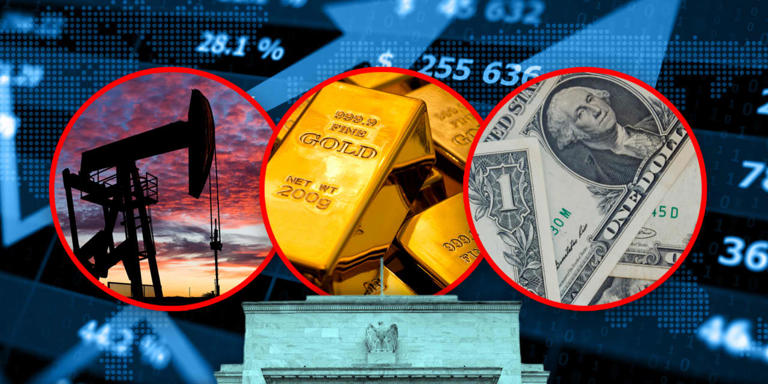In 2024, a robust global economic recovery has ignited a surge in commodity prices, presenting a significant challenge for the Federal Reserve’s efforts to control inflation and potentially complicating its path towards cutting interest rates.
Various commodities, including oil, gasoline, gold, and silver, have experienced notable uptrends, with some reaching levels not seen in years. This rally has reignited concerns about inflation among financial investors.
The Bloomberg Commodity Index, which tracks major commodities futures contracts, has climbed to its highest level since November, driven by energy and gold prices. Geopolitical tensions in the Middle East and the ongoing conflict between Russia and Ukraine have contributed to this surge.
Silver has also seen positive movement, with the iShares Silver Trust posting its best day since May 2023, despite the strengthening U.S. dollar.
Market analysts, including Nanette Abuhoff Jacobson, a global investment strategist at Hartford Funds, suggest that the market is anticipating better-than-expected global growth, increased inflation, and higher commodity prices. This poses challenges for the Federal Reserve’s plan to implement three rate cuts in 2024.
Robust economic data, such as the growth of U.S. factory activity in March and an industrial upswing in China, indicate momentum towards a global economic recovery. China’s economic recovery, in particular, is reversing its disinflationary impact on global markets.
The prospect of a stronger-than-anticipated economic recovery and rising inflation may delay the Fed’s expected rate cuts. This uncertainty has led to a rise in U.S. Treasury yields, with the 10-year Treasury bond reaching its highest level since November.
Overall, the blistering commodities rally and its implications for inflation and monetary policy decisions are creating a complex economic landscape for the Federal Reserve and global markets in 2024.
Oil back in the driver’s seat
In the current market scenario, oil and energy stocks are regaining prominence, with oil prices extending their gains and Brent crude futures inching towards $90 per barrel.
Several factors are contributing to these gains. Firstly, geopolitical tensions, exemplified by Israel’s strike on Iran’s embassy in Syria, are fueling concerns of a broader conflict in the Middle East, thus adding upward pressure on oil prices. Secondly, the decision by OPEC+ ministers to maintain current output cuts in a recent meeting is also supporting oil prices by tightening supply.
However, Stephen Lee of Logan Capital Management suggests that expectations of strong economic growth in the U.S. and other regions are playing a significant role in driving oil prices higher. He emphasizes that oil demand is now more closely tied to economic growth rather than geopolitical conflicts.
The rally in oil prices is positively impacting energy-sector stocks, with the S&P 500 energy sector recording its first record close since 2014. Energy stocks have outperformed other segments of the S&P 500 this week, indicating growing optimism in the sector.
Nicholas Colas of DataTrek Research notes a structural shift in the correlation between oil prices and energy stocks. While historically there hasn’t been a strong correlation between the two, recent market behavior suggests a tighter relationship. Colas suggests that energy stocks tend to perform well when oil prices are on a sustained upward trend, which seems to be the case currently.
Precious metals maintain their footing
Despite the potential for a stronger dollar and central banks tightening their monetary policies, precious metals are maintaining their resilience, driven by increasing physical demand.
Gold achieved its 12th record settlement of the year, while silver closed at its highest level in nearly three years.
Several factors are supporting precious metals:
- Safe-Haven Demand: Tensions in the Middle East and uncertainty about the Federal Reserve’s interest-rate cuts are fueling demand for safe-haven assets like gold and silver.
- Central Bank Purchases: Strong purchases of precious metals by central banks are bolstering the market.
- De-Dollarization Trend: The trend of reducing reliance on the U.S. dollar is also contributing to demand for precious metals.
Nanette Abuhoff Jacobson noted that while the macroeconomic environment supports gold, ongoing interest rate hikes have left some investors cautious, keeping them on the sidelines.
Bank of America Global Research observed a breakdown in the relationship between gold prices and physical bullion-backed ETFs, with declining assets under management in these vehicles. This suggests that retail investors are holding onto cash rather than investing in gold.
Correlation between dollar and commodities
The recent advance in gold and oil prices appears to have diverged from the usual inverse relationship with the U.S. dollar’s strength. Despite the U.S. dollar index reaching its highest level since November, both gold and oil prices have been on the rise. This deviation prompts investors to question whether there’s a shift in the relationship between the dollar and commodities.
Traditionally, gold and the U.S. dollar exhibit a negative correlation, where a strong dollar typically corresponds to weaker gold prices. However, this relationship has weakened recently, with both assets experiencing increased demand as safe-haven investments amid global economic and geopolitical uncertainties.
Similarly, oil also tends to have an inverse relationship with the U.S. dollar. Since oil is priced in dollars worldwide, a stronger dollar should theoretically lead to lower oil prices in dollar terms, as investors would need fewer dollars to purchase the same amount of oil.
The fact that gold and oil prices are rising despite the strength of the U.S. dollar suggests that other factors, such as supply constraints, geopolitical tensions, and investor sentiment, may be outweighing the usual impact of currency fluctuations on commodity prices. This divergence highlights the complex interplay of various factors in commodity markets and underscores the need for investors to carefully consider a range of factors beyond just currency movements when analyzing commodity price trends.
